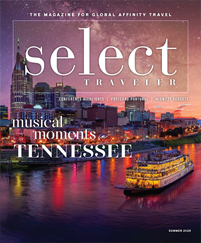A meandering trip through Alabama, starting in the music mecca of Muscle Shoals and ending on the Gulf of Mexico at Mobile, is almost like Forrest Gump’s box of chocolates: “You never know what you’re gonna get.”
One thing is certain, however: The surprises are delightful.
This particular itinerary includes the music of the Rolling Stones and Linda Ronstadt, a burger and a beer in an Appalachian cave, rocket ships, spectacular waterfalls, real tigers, a baseball museum that appeals to sports and history buffs, a gigantic statue of a Roman god, peach ice cream, a riverboat cruise and a sobering stop at the site where the last kidnapped and enslaved Africans landed in America.
The Music of the Shoals
Up in the northwest corner of Alabama is the Shoals, a collective name for four cities (Florence, Sheffield, Tuscumbia and Muscle Shoals) that are united by music and divided by the Tennessee River. There’s no doubt you’ve heard music from the Shoals, and you can immerse yourself in it by touring two recording studios and a tribute museum.
At FAME Recording Studios in Muscle Shoals, you can soak in the soulful memories of Aretha Franklin, Wilson Pickett, Otis Redding and other stars who created 350 million recorded or published cuts in this very unassuming building. Nearby in Sheffield is the Muscle Shoals Sound Studio, often simply called 3614 Jackson Highway. This was home to the Muscle Shoals Rhythm Section (also known as the Swampers), and the parade of artists who recorded here includes Cher, the Rolling Stones, Bob Dylan, Paul Simon, Leon Russell, Linda Rondstadt and dozens more.
The Alabama Music Hall of Fame in Tuscumbia honors scores of people connected to Alabama’s musical heritage. Among them are Nat “King” Cole, Hank Williams, W.C. Handy (father of the blues), the Louvin Brothers, Tammy Wynette, Jimmie Rodgers (the father of country music), Lionel Richie, Percy Sledge, Emmylou Harris and, yes, the country music group Alabama.
A lodging tip: The Marriott Shoals Hotel and Spa in Florence is one of the area’s biggest properties, and its 360 Grille delivers a commanding view of the Tennessee River. Listen for live music at the Swampers Bar.
A dining tip: Time your tour for a burger and a beer — and probably some live music — at the Rattlesnake Saloon just west of Tuscumbia. What you’ll remember most is the location. It is tucked underneath a gigantic rock overhang, meaning that your hosts are welcoming you to a cave.
Rockets, Waterfalls and Tigers
Head east from the Shoals for Alabama’s most visited attraction: the U.S. Space and Rocket Center in Huntsville, a hit from the day it opened in 1970. NASA’s Artemis II mission, the first crewed trip to the moon in more than 50 years, is planned for 2024, and you can learn about the roots of America’s space exploration efforts here. You’ll marvel at the gigantic Saturn V rocket (one of only three in the world), especially when comparing it to the cramped quarters of an Apollo lunar landing craft.
While the moon is more than 225,000 miles away, you can turn your sights just 75 miles east to enjoy some of Alabama’s Appalachian terrain and a collection of accessible waterfalls.
John Dersham, president/CEO of DeKalb Tourism in Fort Payne and a noted nature photographer, enjoys steering visitors to places such as 104-foot-tall DeSoto Falls in DeSoto State Park, Little River Falls in Little River Canyon National Preserve and Noccalula Falls in Gadsden. A north-to-south roll to see all three covers only about 60 miles and delivers memorable photographs.
A shopping tip: Before getting to waterfall country, consider stopping in tiny Scottsboro at Unclaimed Baggage, the nation’s only retailer of lost luggage. Airlines don’t lose many bags forever, but some are never claimed, and their contents end up here. What can you find? Absolutely anything someone might pack — newly purchased clothes, binoculars, Kindles, AirPods, jewelry, and even wedding gowns.
Between Little River Falls and just off Interstate 59 is a place where you can quote a line from Dorothy in “The Wizard of Oz.” It goes like this: “Lions and tigers and bears, oh my!”
The line is logical at the Tigers for Tomorrow, a rescued animal preserve on Untamed Mountain. Really, that’s where it’s located. It is home to eight species of big cats (definitely lions and tigers), black bears, brown bears, wolves, coyotes, hyenas and foxes, plus several more benign animals such as Hansel and Gretel, who are capybaras, the world’s biggest rodent.
Tigers for Tomorrow is a walk-around attraction, and it exists for more than providing safety for the carnivores. Environmental education and conservation are key parts of its mission.
A Roman God and Baseball in Birmingham
Birmingham’s modern economy — big in health care, higher education and banking — almost obscures its industrial past as a steelmaking city nicknamed the “Pittsburgh of the South.” However, the city offers a conspicuous reminder of its history.
High on Red Mountain is a towering statue of Vulcan, the mythological Roman god of fire and forge. Italian sculptor Giuseppe Moretti designed the 56-foot-tall figure to represent Birmingham in the 1904 World’s Fair in St. Louis, and Vulcan came home afterward. He resided at the Alabama State Fairgrounds for decades before relocating to his mountaintop perch in 1939.
Today, the compact but highly informative museum tells Birmingham’s steelmaking history, and a trip to the observation deck of the statue delivers a panoramic view of modern Birmingham in the valley below.
One of Birmingham’s prides is Railroad Park, a 19-acre greenspace in the middle of the city. It is a perfect place for tour participants to stretch their legs and check out attractions such as baseball’s Negro Southern League Museum, which is adjacent to the city’s minor league baseball stadium.
You don’t need to be a fan of baseball to appreciate the Negro Southern League Museum. Yes, it is about baseball, but its deeper story is a look at American life through sports. Birmingham was a major player in the nine major Negro leagues that operated from 1920–63. One of the museum’s exhibits explains that the previously white Birmingham Barons were Alabama’s first integrated professional sports team, well before the state’s schools, lunch counters and college football teams accepted minorities.
Peaches and a Riverboat Cruise
Heading south from Birmingham puts you in the middle of an Alabama culinary treat — peach country. Chilton County, where Clanton is the county seat, is the epicenter for everything peachy, and you don’t have to drive through during harvest season to have a sweet time.
A multi-faceted family business called Peach Park is a popular stop right along Interstate 65 in Clanton. Of course, it has peaches (usually May through Labor Day, with many varieties that ripen at different times), but it is just as famous for peach ice cream, handheld peach pies and peach cobbler.
Peach Park opened in 1984, and it premiered its peach ice cream in 1988. The second generation of the Gray family keeps churning out ice cream and serving “Peach Pit Bar-B-Que,” peach preserves, peach bread and more. Remember to have a big supply of napkins if you get a bushel for the motorcoach. They’re juicy.
You can keep food foremost in your thoughts with an Alabama River dinner cruise through the heart of Montgomery, Alabama’s capital, aboard the Harriott II riverboat. The two-hour trip features a plated meal, with inside seating on the first and second decks. The menu changes through the year. Check to see whether your cruise offers baked chicken, barbecue chicken, St. Louis-style ribs, fried catfish or another entrée. At holiday time, the dinner is sirloin steak and skewered shrimp.
The Harriott II offers two-hour daytime trips as well, with two climate-controlled decks and outdoor seating on the top deck. Sundays have the special treat of a Blues Cruise that showcases local blues entertainers.
A Somber Stop in Mobile
A north-to-south Alabama tour usually ends on the white sands of the Gulf of Mexico at Gulf Shores and Orange Beach, but plan a stop in Mobile at the Africatown Heritage House, a purpose-built place to tell the story of the Clotilda.
The Clotilda was the last ship to bring enslaved Africans to the United States, a fact made worse because its arrival was in 1860, more than 50 years after the importation of slaves was outlawed. The Clotilda carried 110 men, women and children. Some of the survivors lived into the 1920s, and they and their descendants created the community of Africatown.
While the focus of the Africatown Heritage House is on the 110 human beings at the center of the story, there is also interest in the Clotilda itself. The slave traders had the ship taken up the Mobile River, burned and sunk to hide their treachery. Roughly two-thirds of the ship lay buried in mud until the wreckage was publicly identified in 2019, furthering efforts to tell the stories of its kidnapped passengers. The museum opened in 2023 for individual visits, and group tours will begin in 2024.









